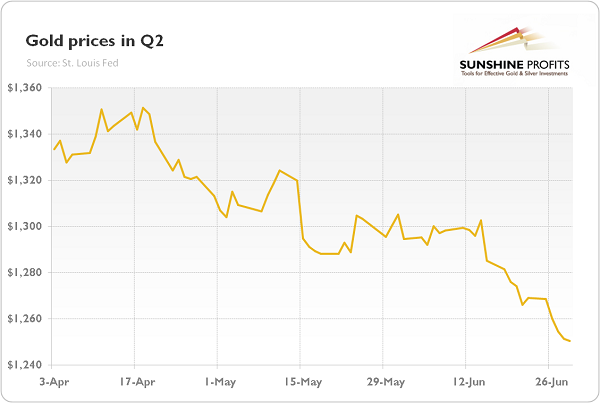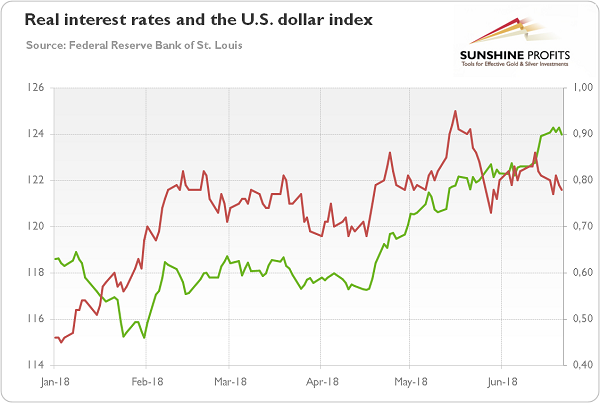Gold Drops Below $1,250
What a fall! The price of gold dropped about $100 since mid-April, or about $50 since mid-June. What is happening in the precious metals market?
World Is Dangerous, but Gold Falls in Q2
Let’s analyze the chart below. As one can see, the second quarter of 2018 was not good for gold. The yellow metal lost almost 6 percent. June was particularly negative for gold, which dropped more than 4 percent that month, making new lows almost every day.
Chart 1: Gold prices in Q2 of 2018 (London P.M Fix, in $).

The bear market in gold has been surprising for many analysts. They ask: Why the hell gold, which is a safe-haven asset, is failing amid unstable geopolitical environment? But the political environment has recently improved on several fronts. Tensions between the U.S. and North Korea diminished, as well as between the U.S. and Russia – Trump is going to meet Putin in July. The POTUS also expects second tax overhaul this year. Anyway, our readers know that geopolitical factors are not very significant in the long-run. The macroeconomic drivers are much more important. Let’s look at them.
Greenback Beats Gold
Trade wars should be theoretically positive for the gold prices. However, the daily life is more complicated that theory. We mean here the possibility that investors believe that trade wars will narrow the U.S. trade deficit which will strengthen the U.S. dollar (due to the less trade with the world). And, as we already pointed out in the past edition of the Gold News Monitor, “they supported the greenback, which put downward pressure on the yellow metal.” Indeed, please take a look at the chart below. Although the real interest rates have declined since May, the greenback has appreciated significantly, hurting the gold prices.
Chart 2: Real interest rates (red line, right axis, 10-year inflation-indexed Treasuries, in %) and the U.S. dollar strength (green line, left axis, broad trade weighted index) in 2018.

It seems that investors have finally reacted to the Fed’s tightening. Our readers should be aware that historically speaking the U.S. dollar reacted with some delay to the interest rates hikes. As we wrote in the last edition of the Market Overview, “USD Index’s reaction to the series of interest rate hikes could have been simply delayed, just like it was the case from 2002 to 2005. The history tends to rhyme and this time the rhyme seems to be loud and clear”.
Investment Implications
What does it all imply for gold investments? Should investors try to predict the exact bottom? Not really, unless somebody is really good at catching falling knives. Investors should be patient and remember that the new bull market will start one day. Actually, as readers of our Gold & Silver Trading Alerts, know, the short-term outlook is rather bullish. The market sentiment is very pessimistic right now, so the bull trend may surprise many investors.
In the medium-run, we are not so optimistic, as the normalization of monetary policy “reduce the attractiveness of gold as an inflation hedge which protects investors against the monetary madness of central banks.” As long as the markets expect more monetary tightening (combined with the pro-growth fiscal stimulus), the U.S. dollar should appreciate, putting downward pressure on gold.
However, investors should remember that we approach the end of the U.S. tightening cycle, while other major central banks – such as the ECB and the Bank of Japan, are in the early stages of policy normalization. It should eventually weaken the U.S. dollar against the euro and the Japanese yen, being supportive of gold.
Aren’t we contradictory? Well, not really. It is just necessary to adopt a proper time perspective, as gold outlook may be completely different depending on the time horizon.
Arkadiusz Sieron
Sunshine Profits - Free Gold Analysis
* * * * *
All essays, research and information found above represent analyses and opinions of Przemyslaw Radomski, CFA and Sunshine Profits' associates only. As such, it may prove wrong and be a subject to change without notice. Opinions and analyses were based on data available to authors of respective essays at the time of writing. Although the information provided above is based on careful research and sources that are believed to be accurate, Przemyslaw Radomski, CFA and his associates do not guarantee the accuracy or thoroughness of the data or information reported. The opinions published above are neither an offer nor a recommendation to purchase or sell any securities. Mr. Radomski is not a Registered Securities Advisor. By reading Przemyslaw Radomski's, CFA reports you fully agree that he will not be held responsible or liable for any decisions you make regarding any information provided in these reports. Investing, trading and speculation in any financial markets may involve high risk of loss. Przemyslaw Radomski, CFA, Sunshine Profits' employees and affiliates as well as members of their families may have a short or long position in any securities, including those mentioned in any of the reports or essays, and may make additional purchases and/or sales of those securities without notice.

















